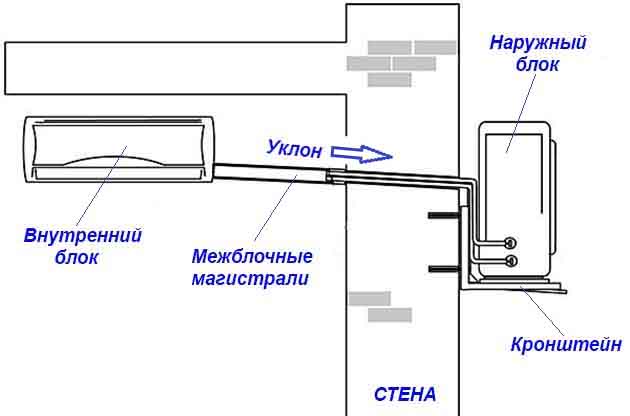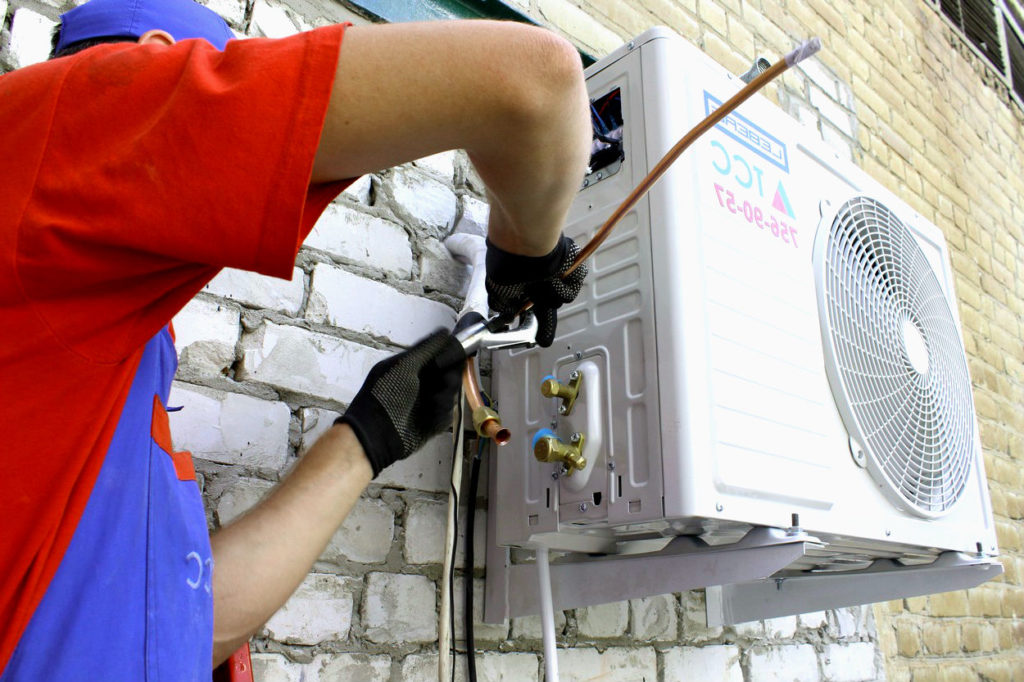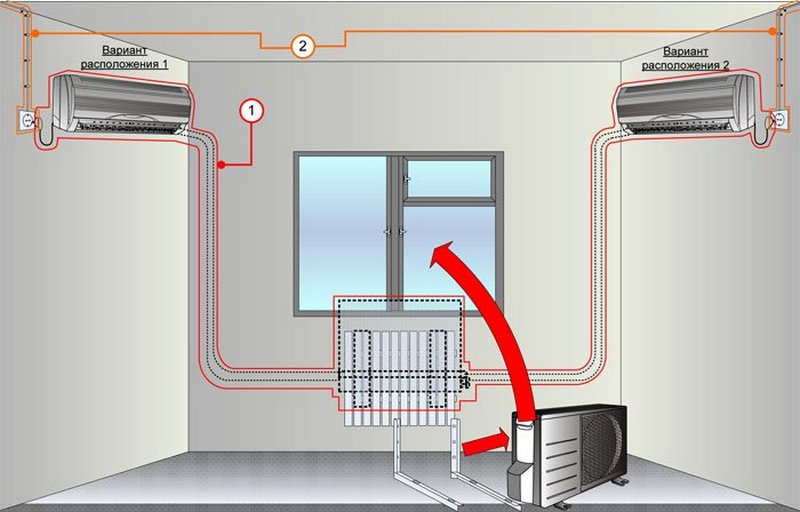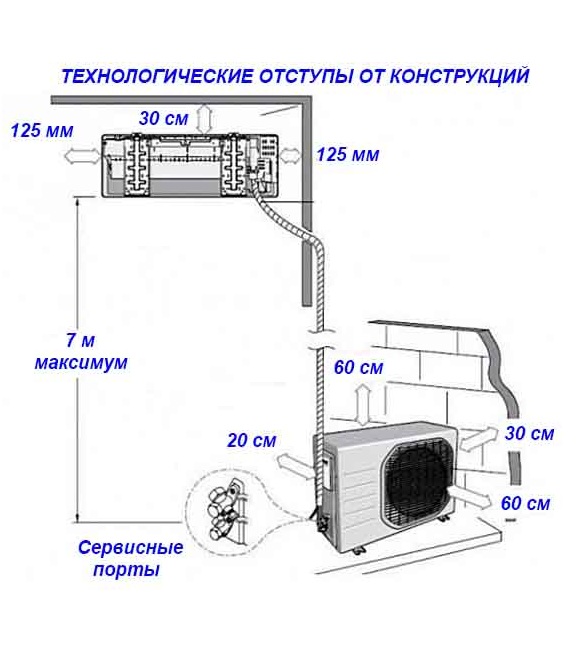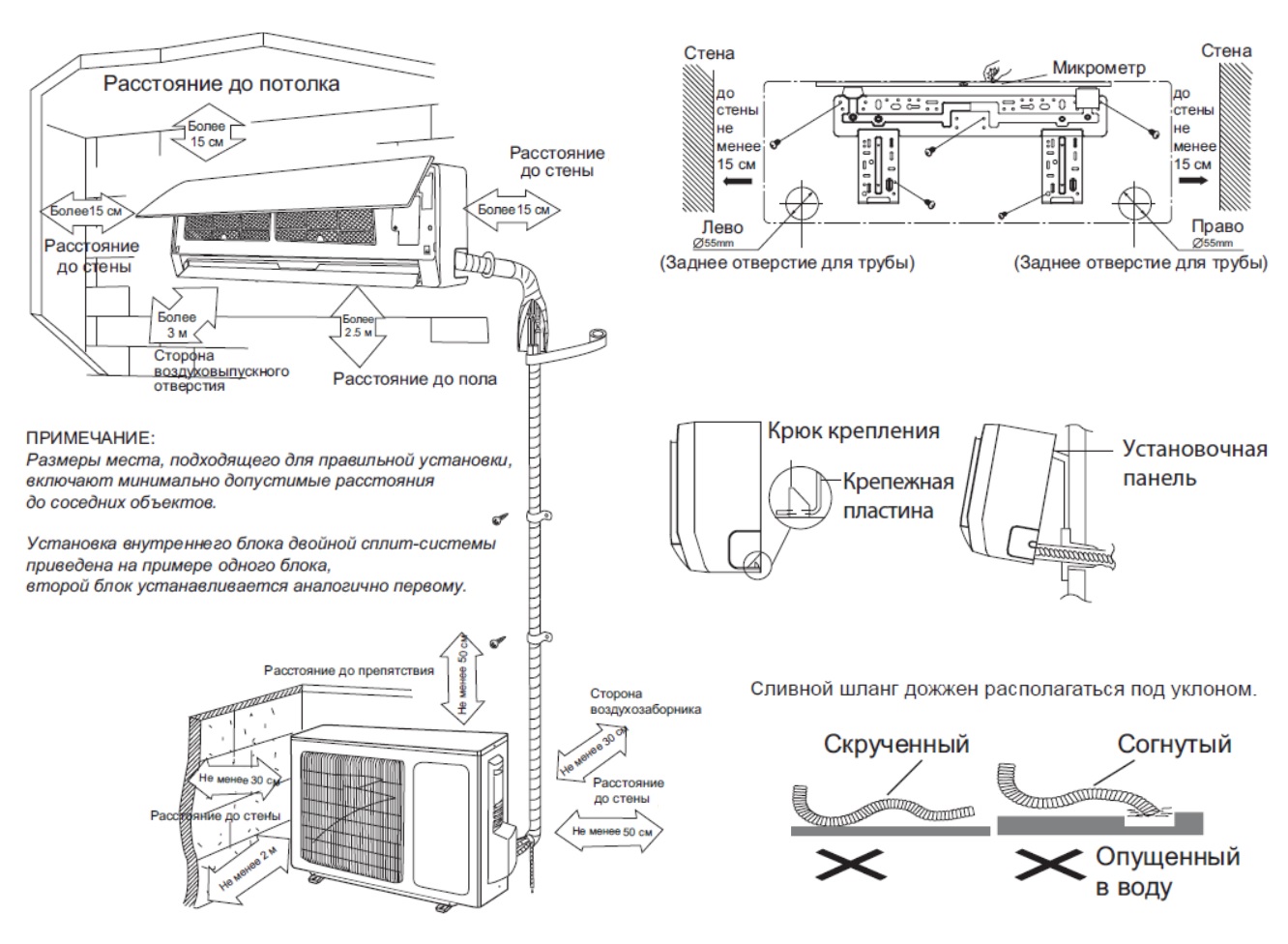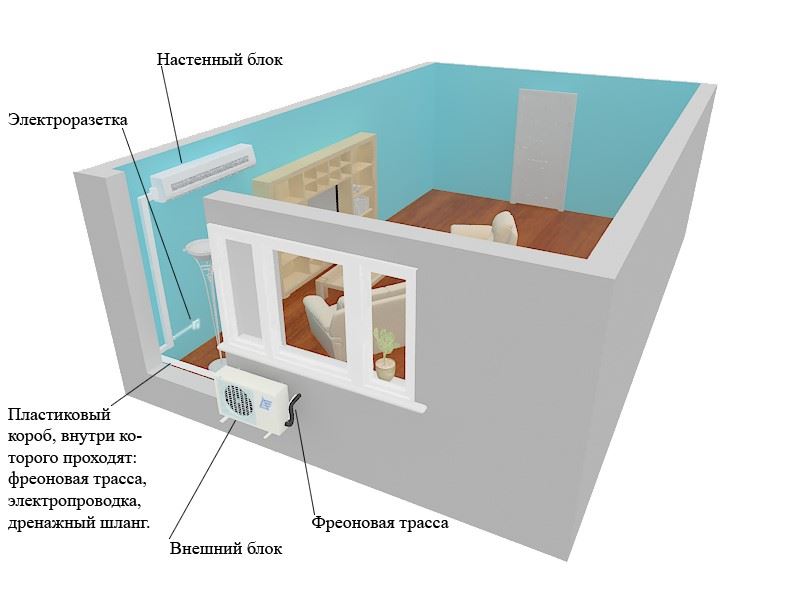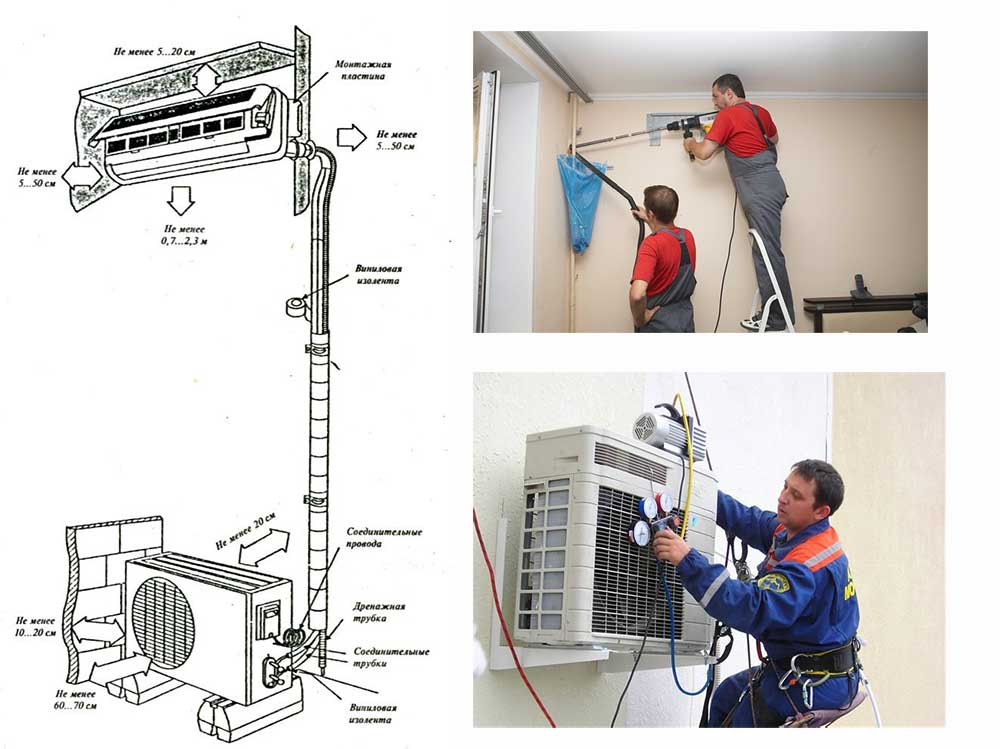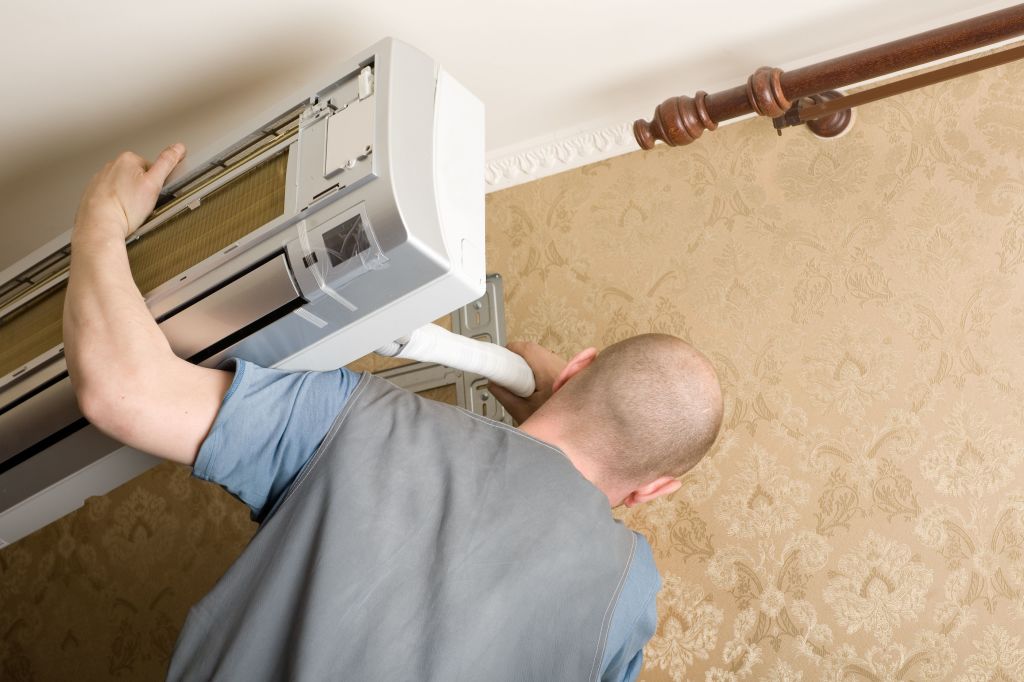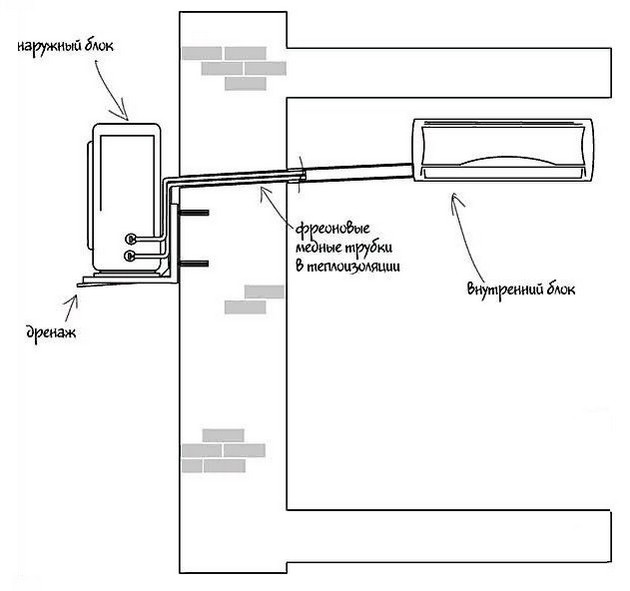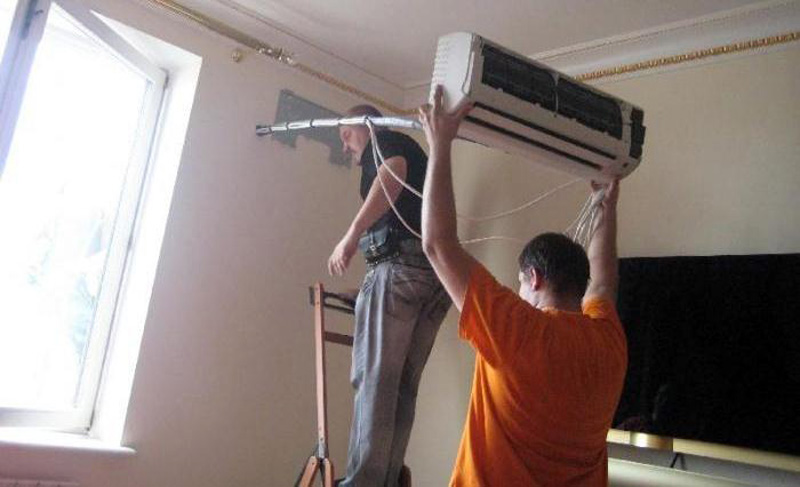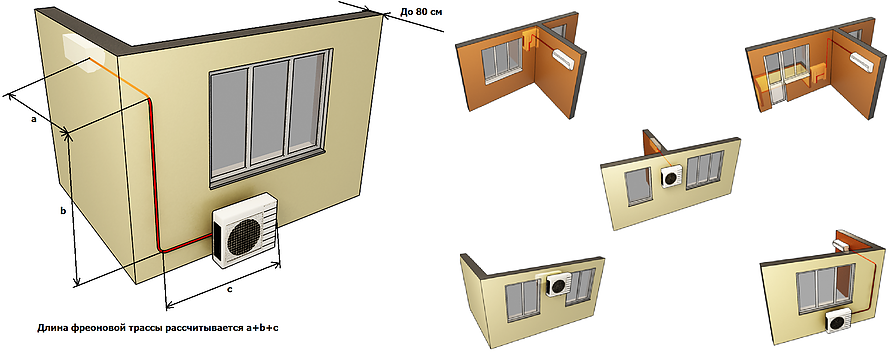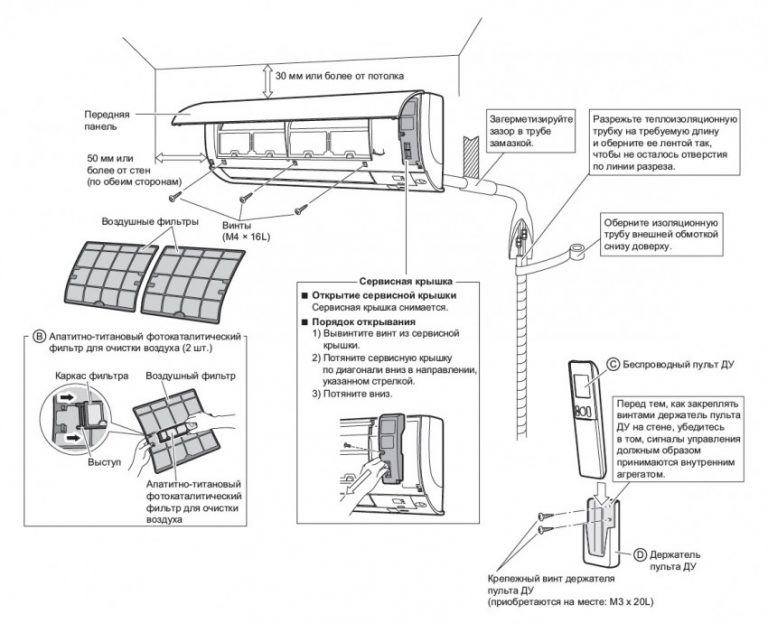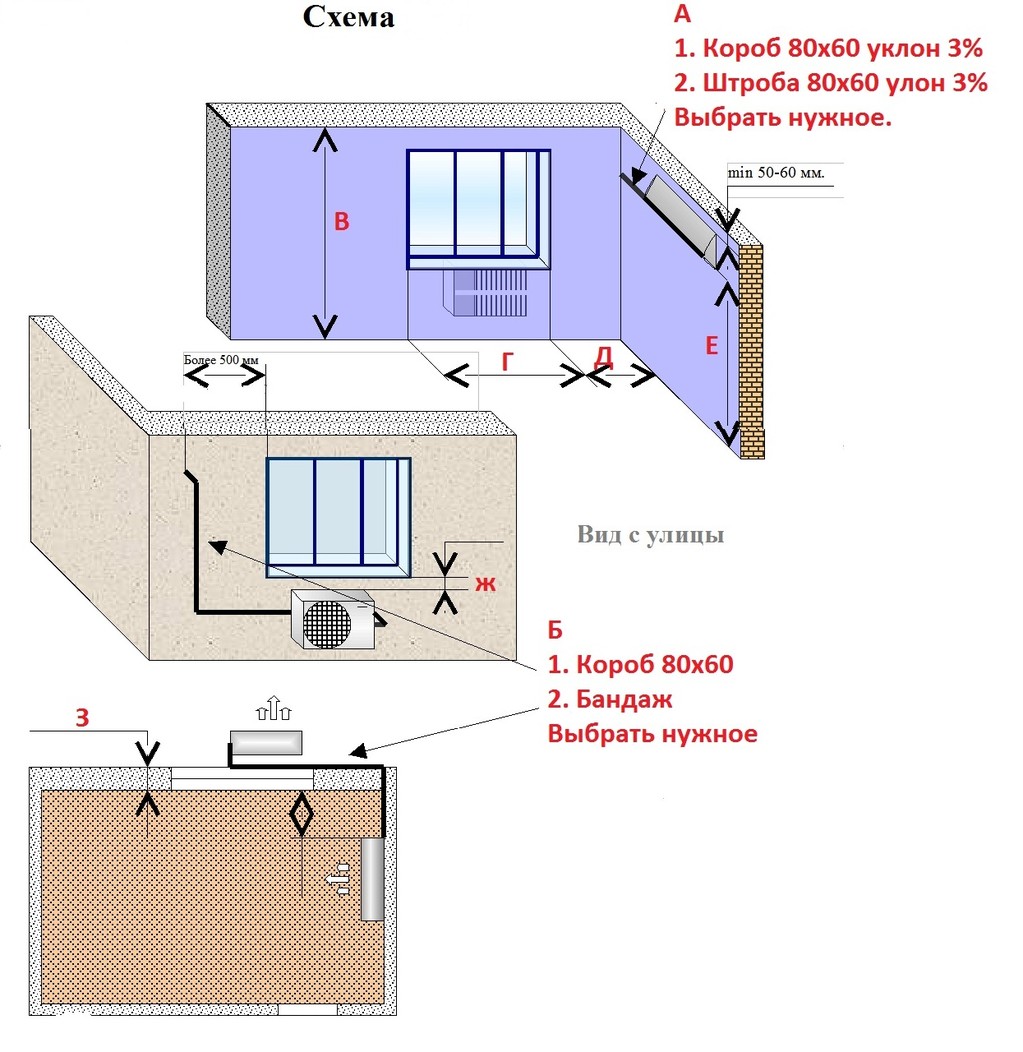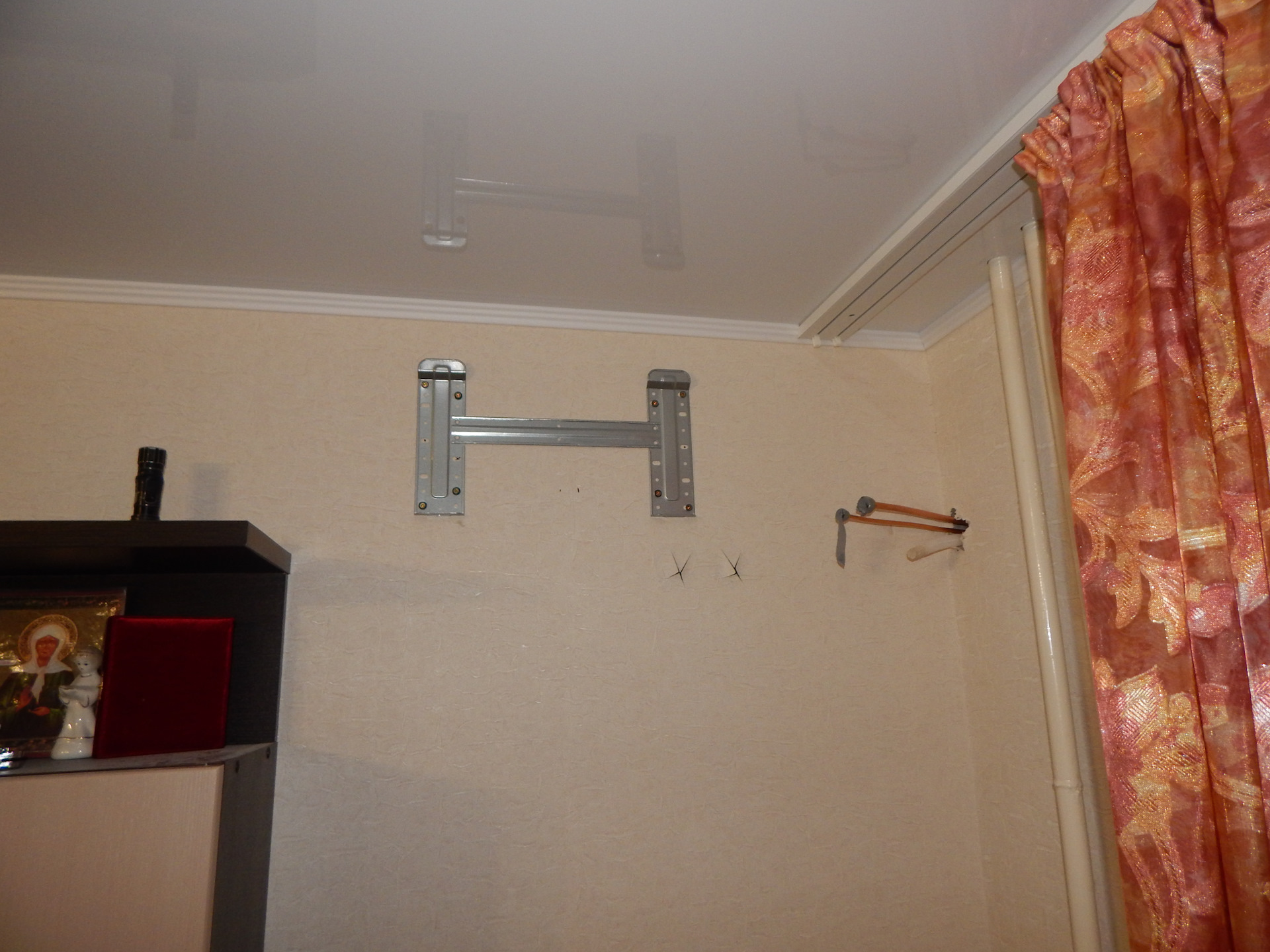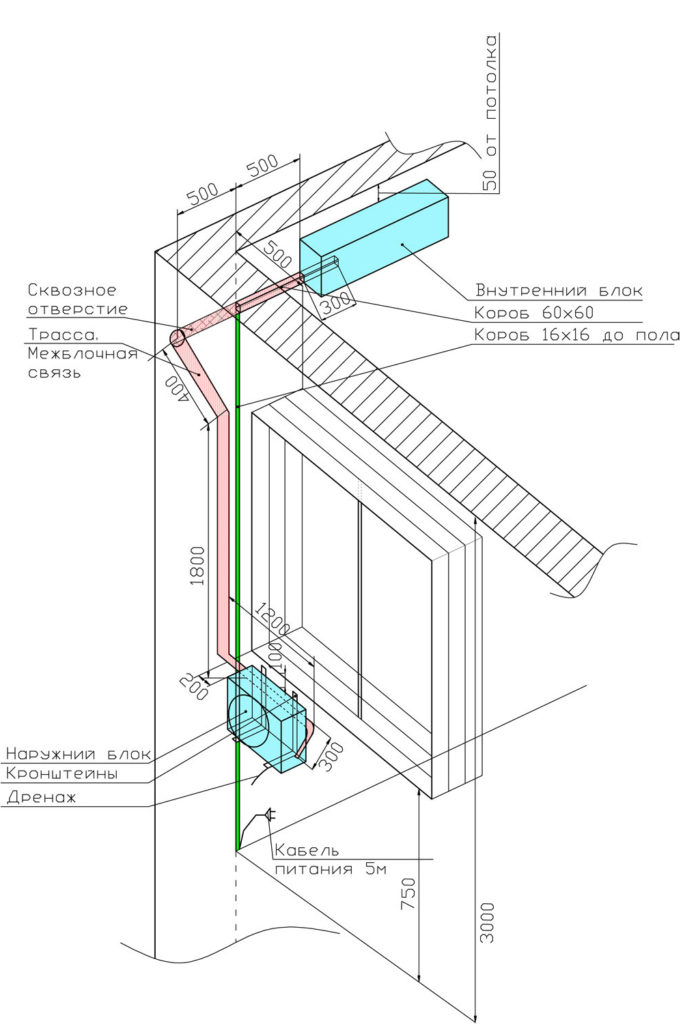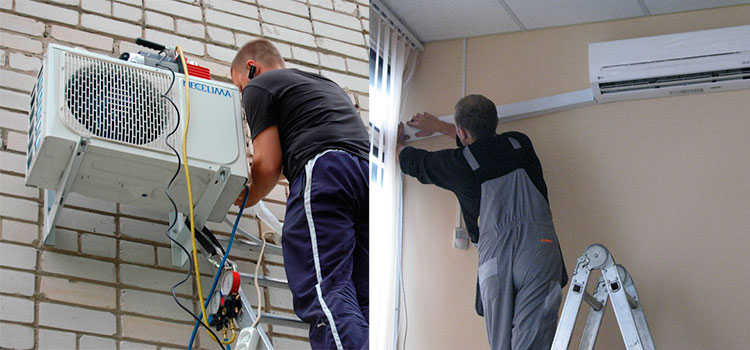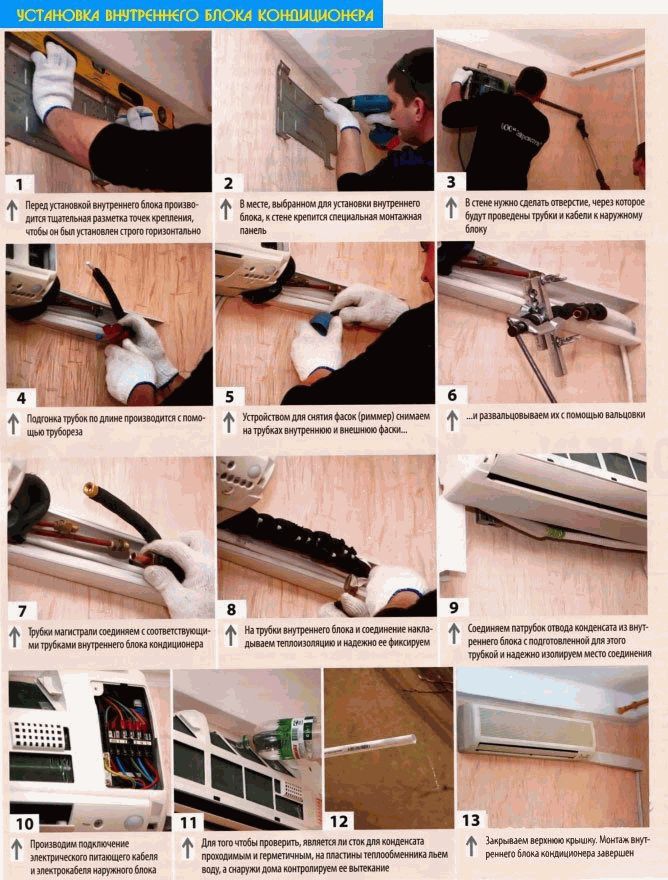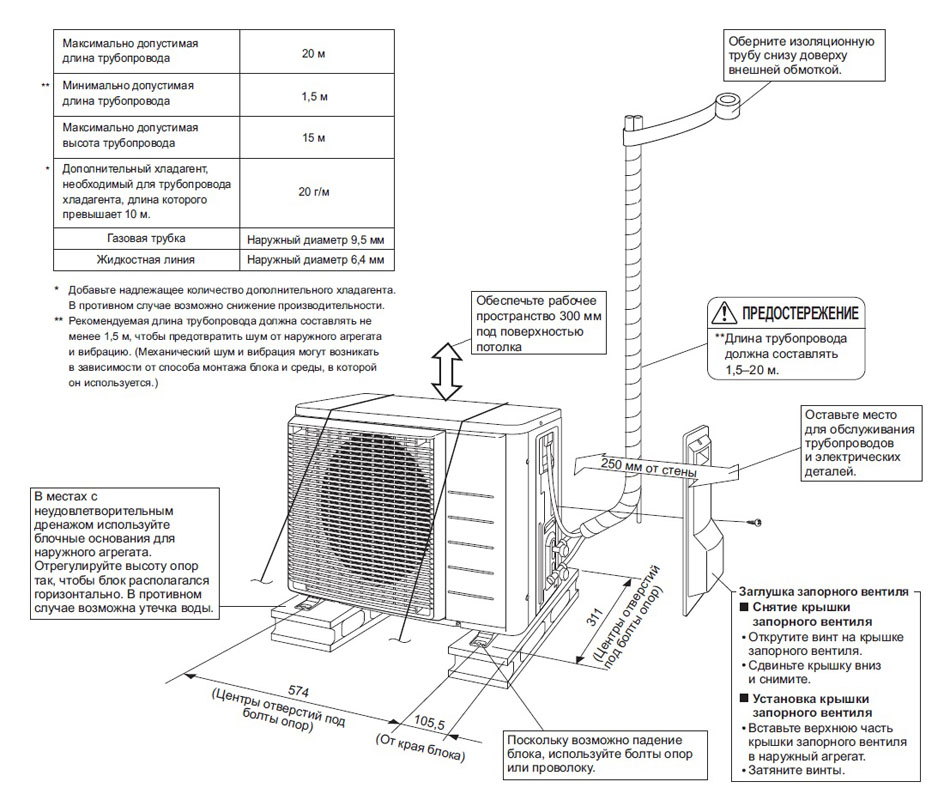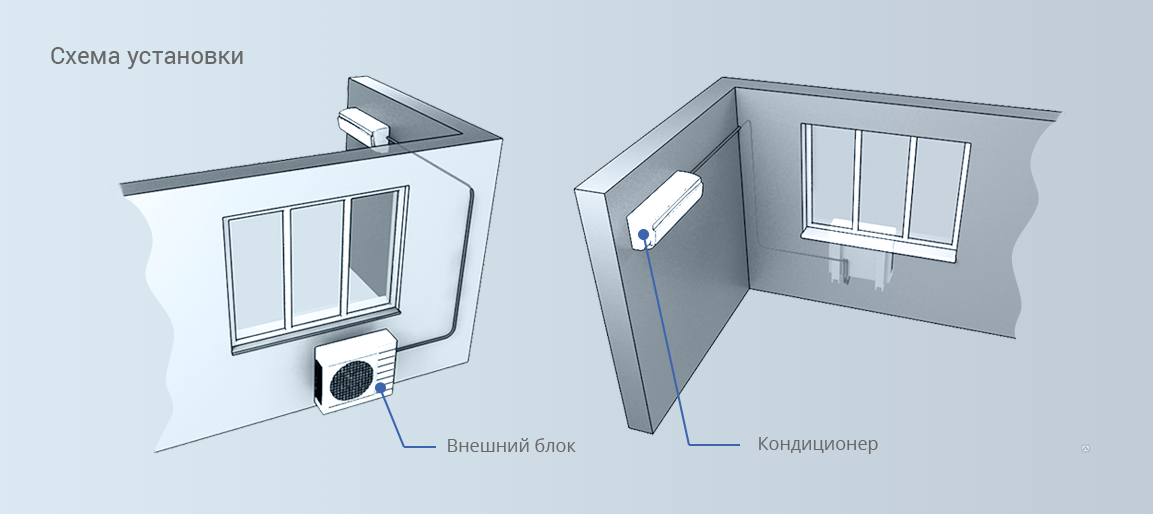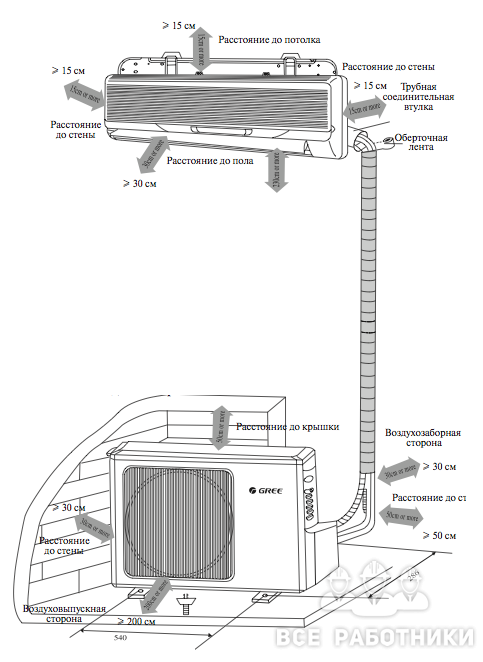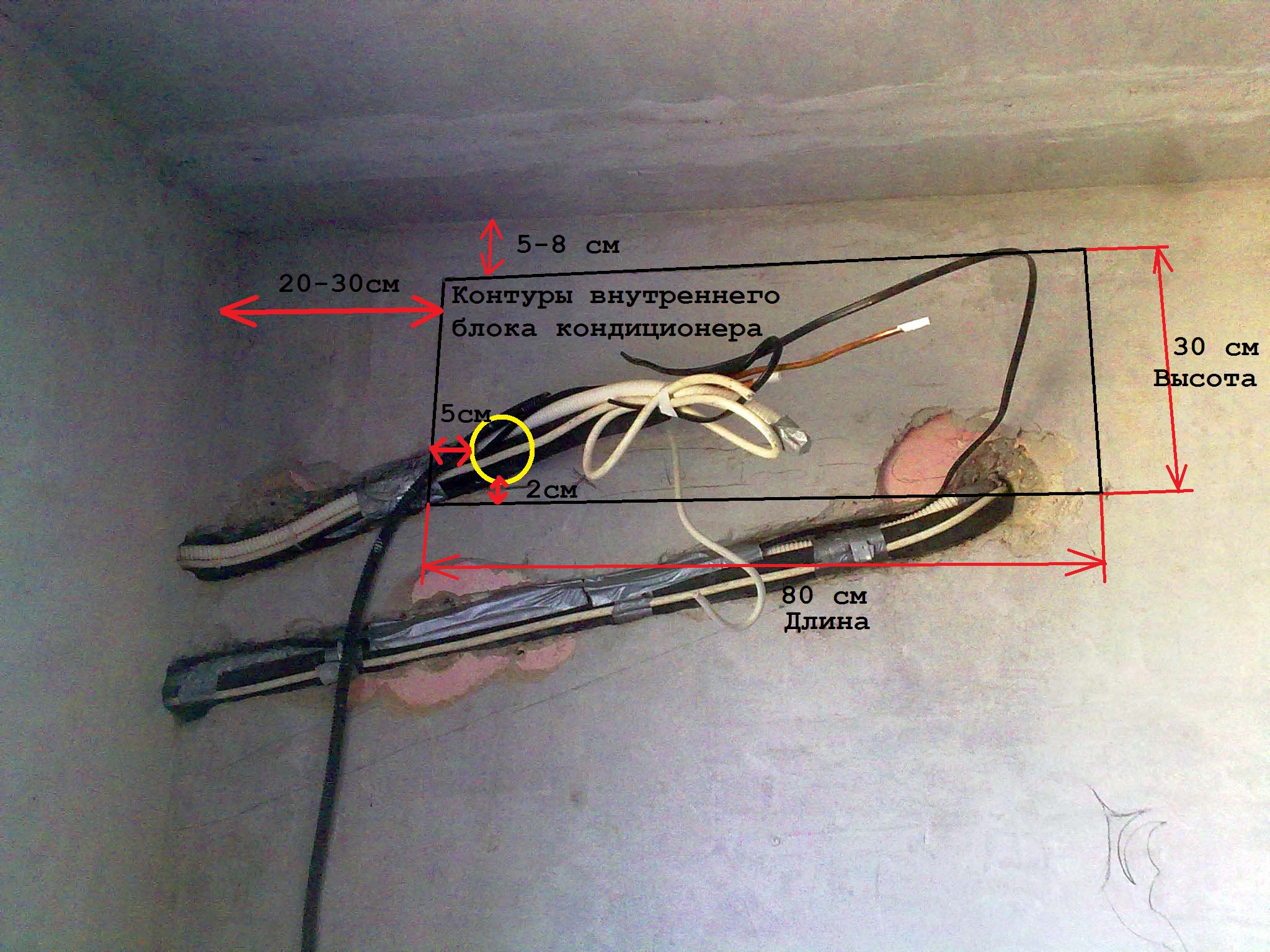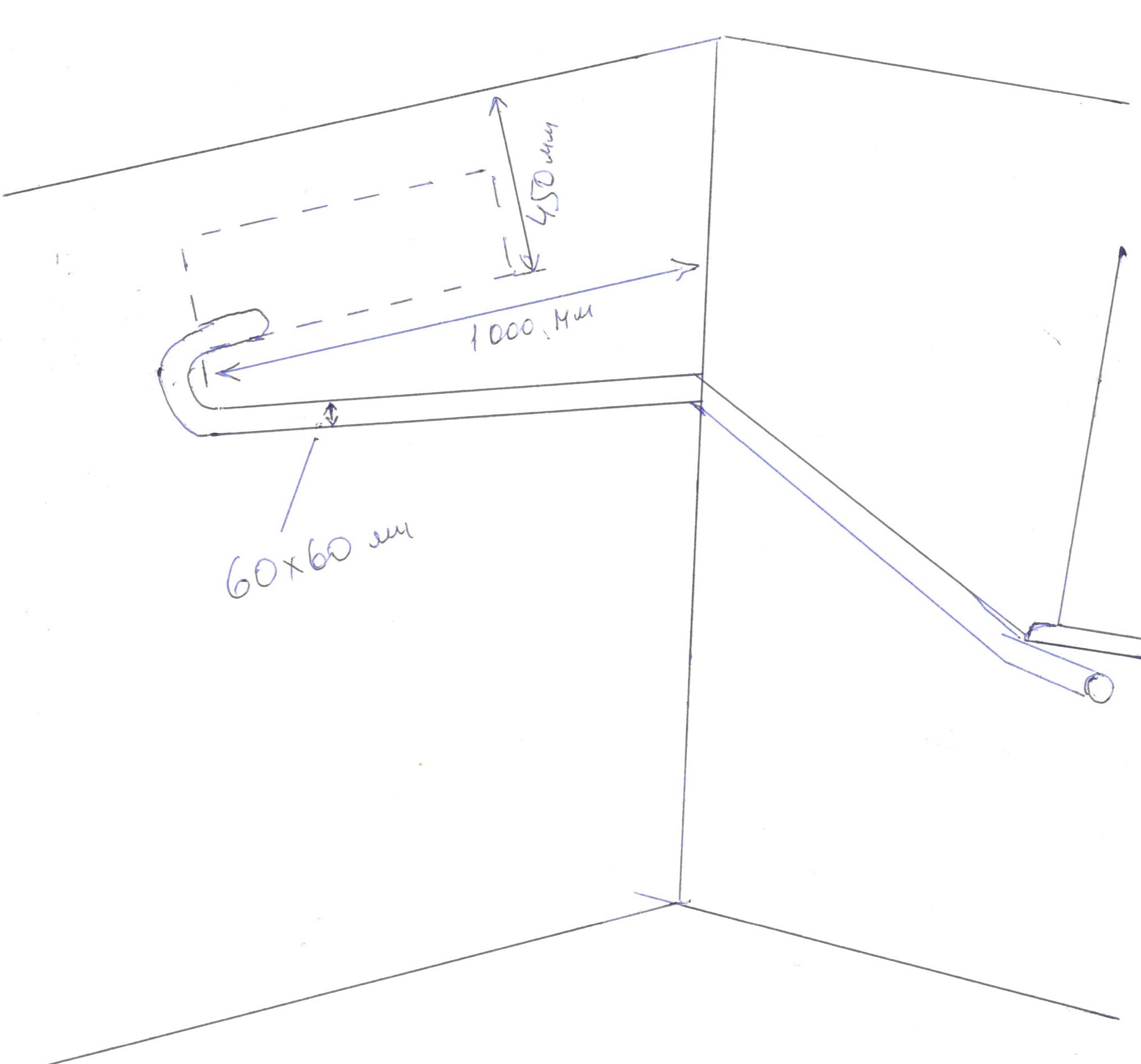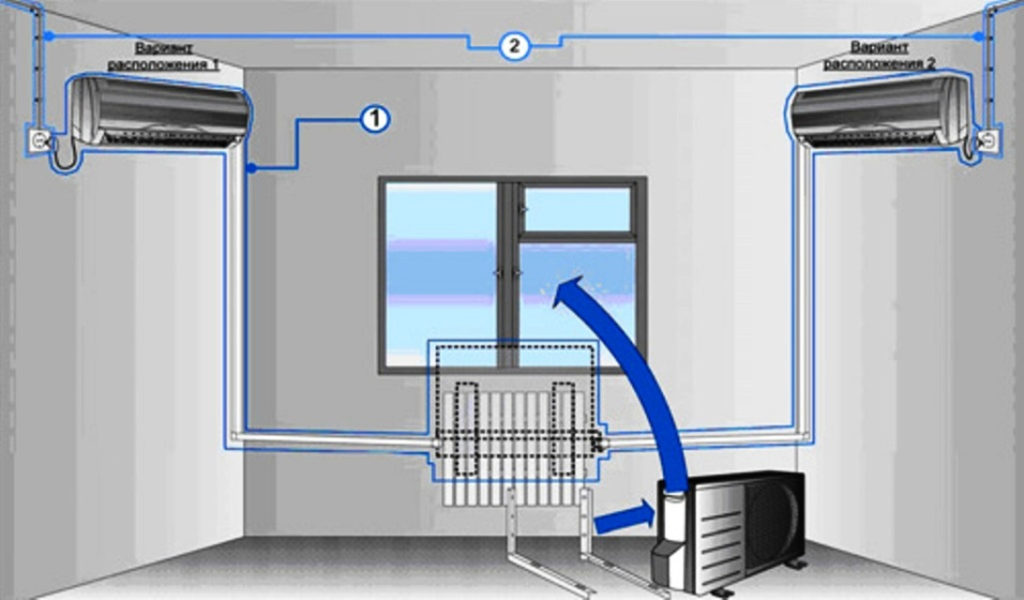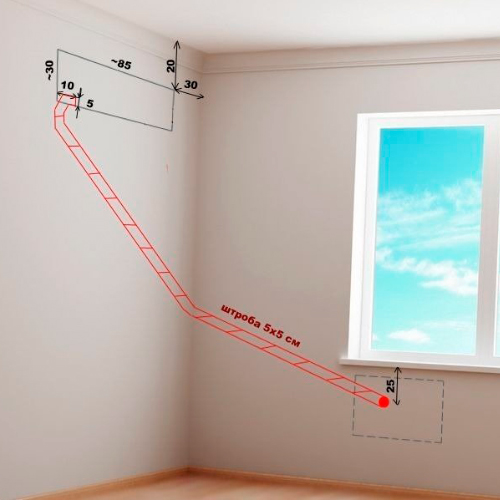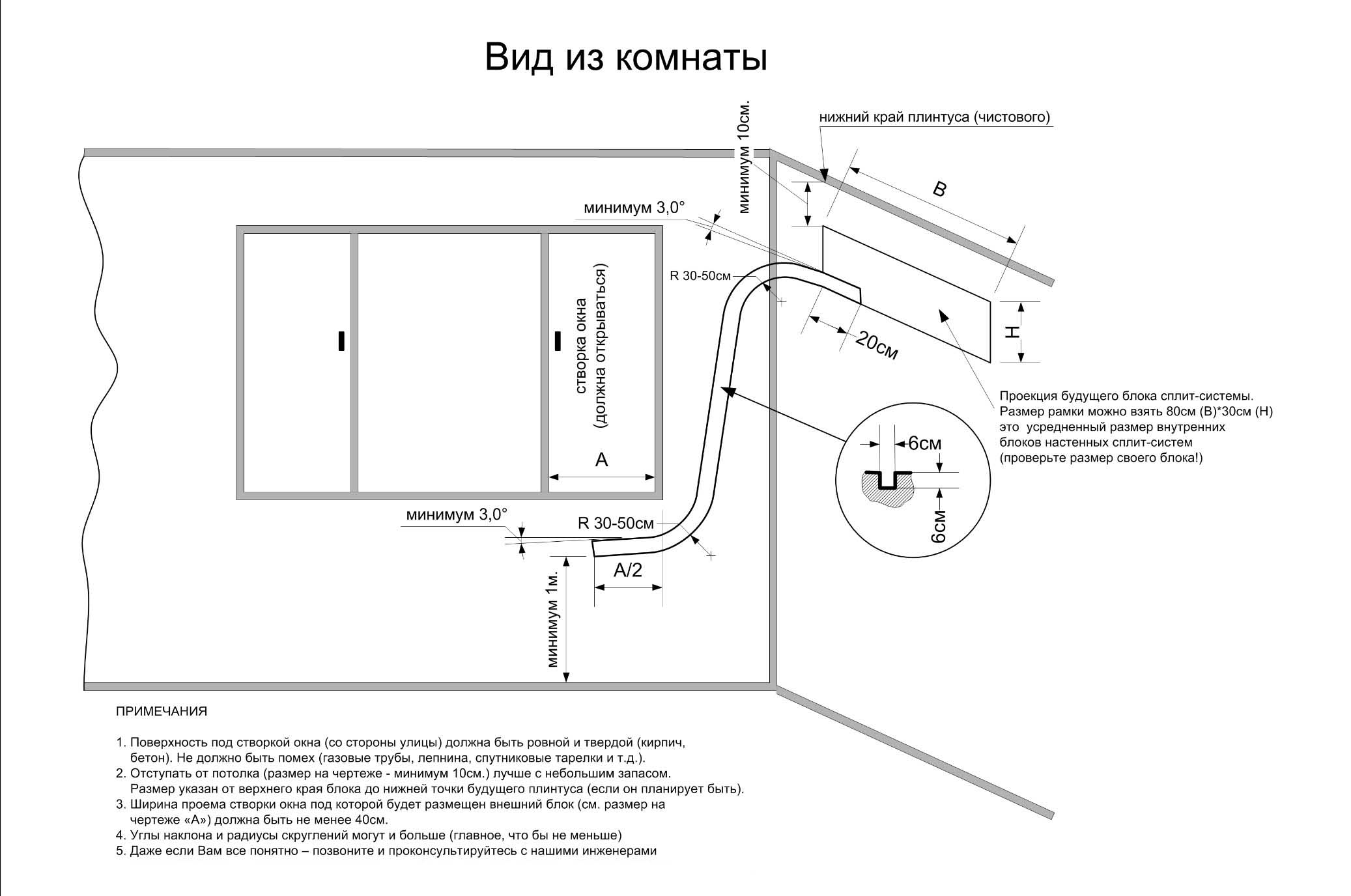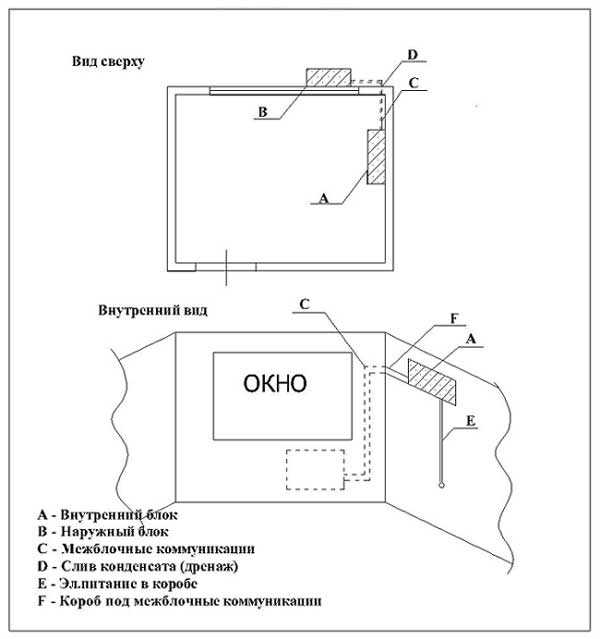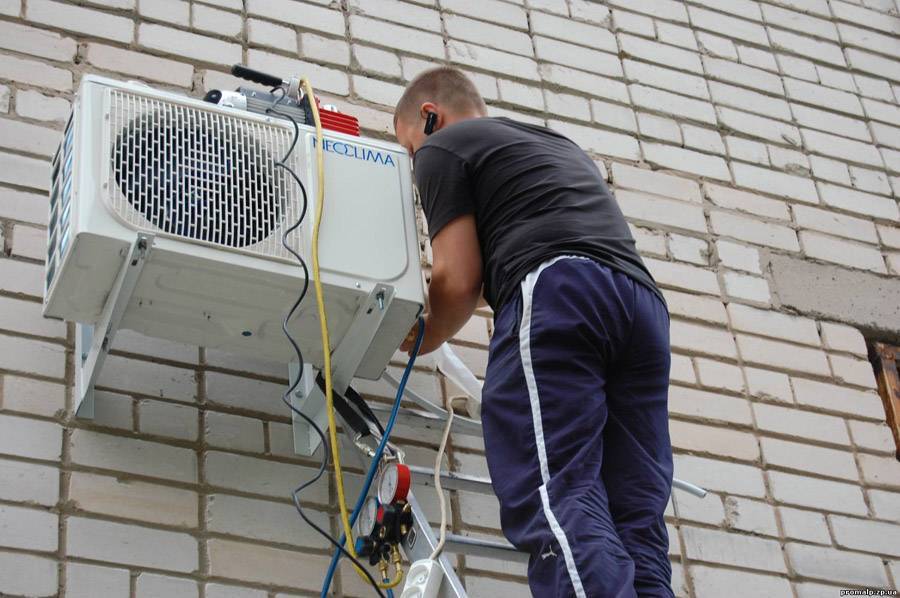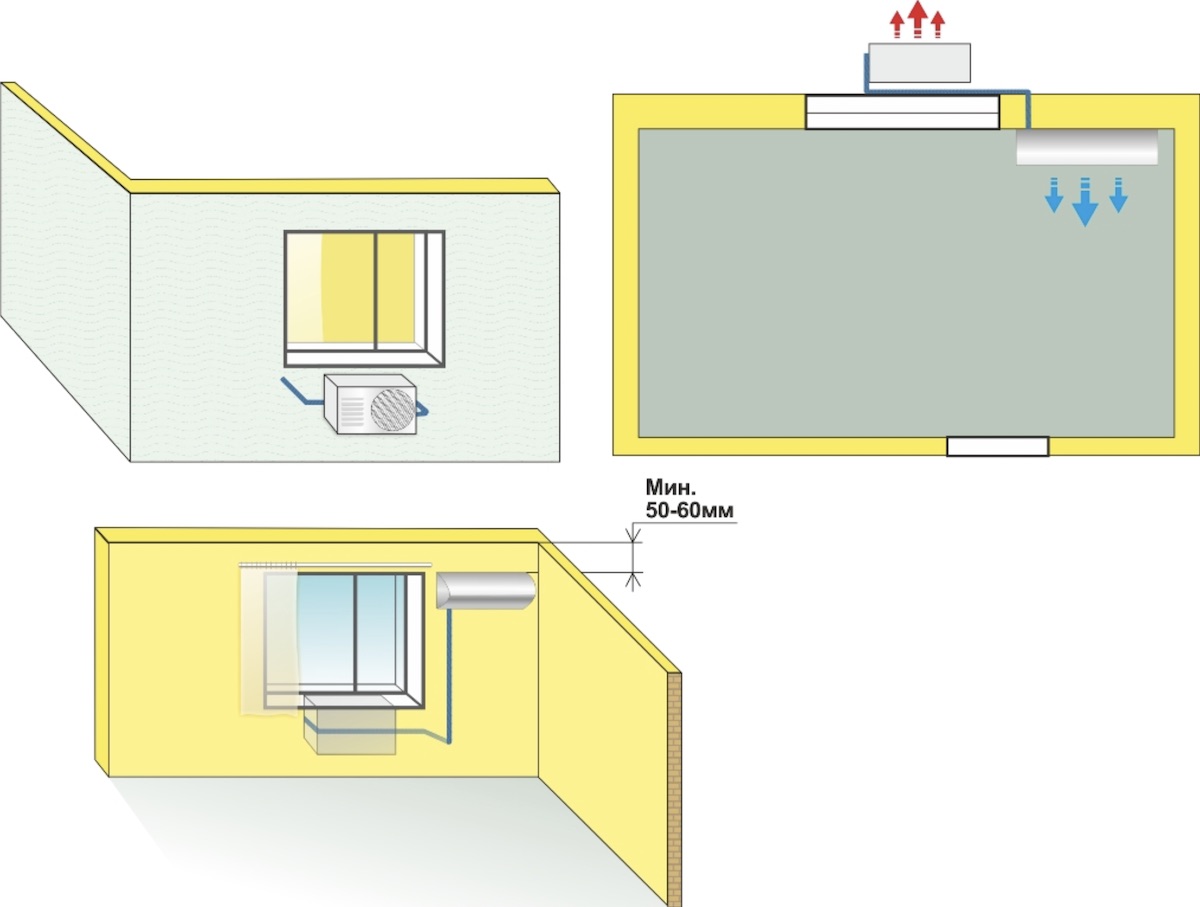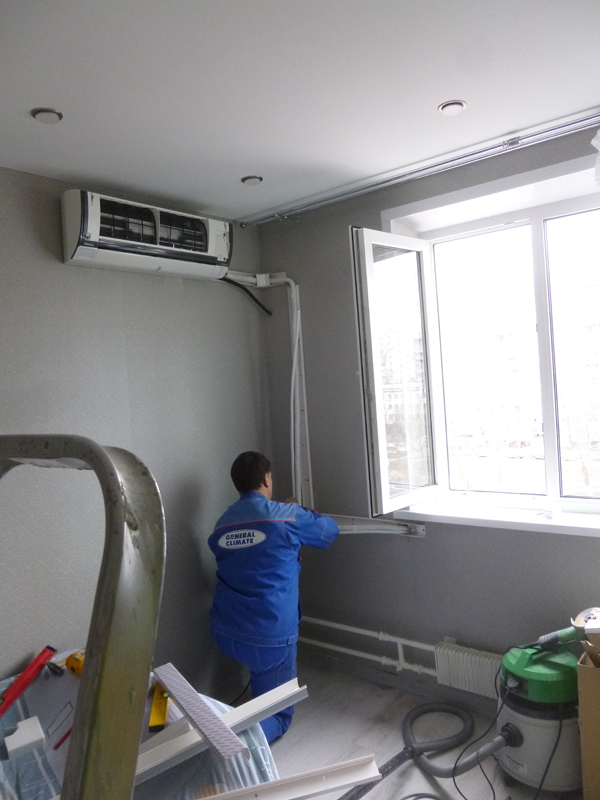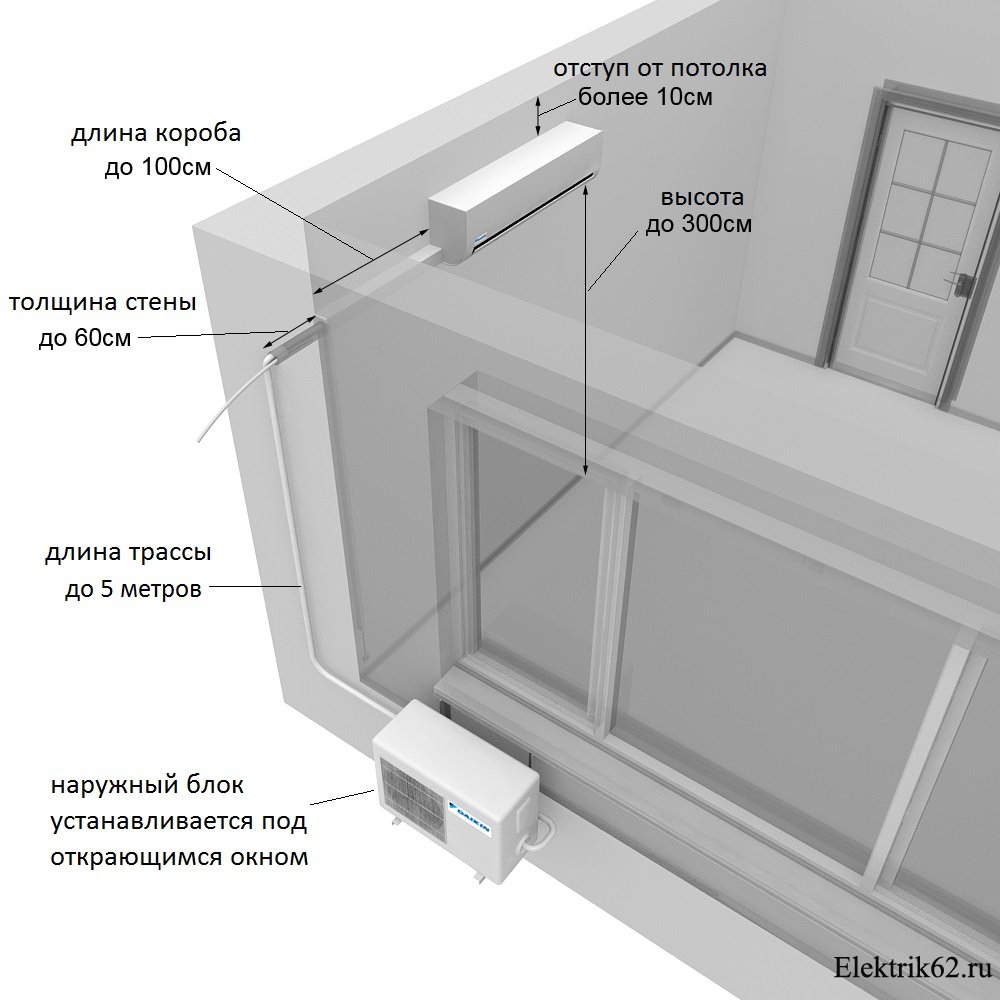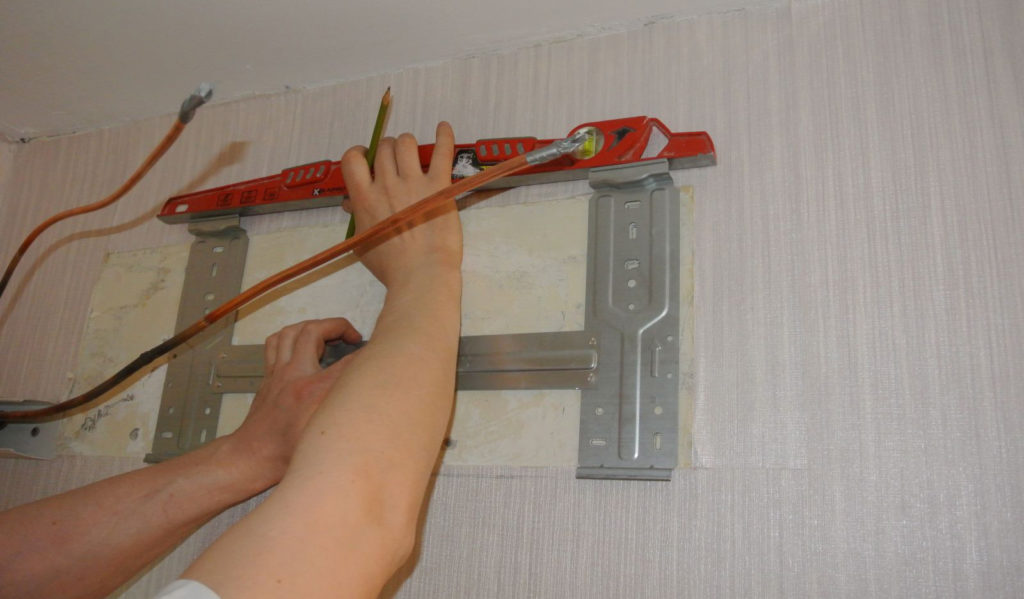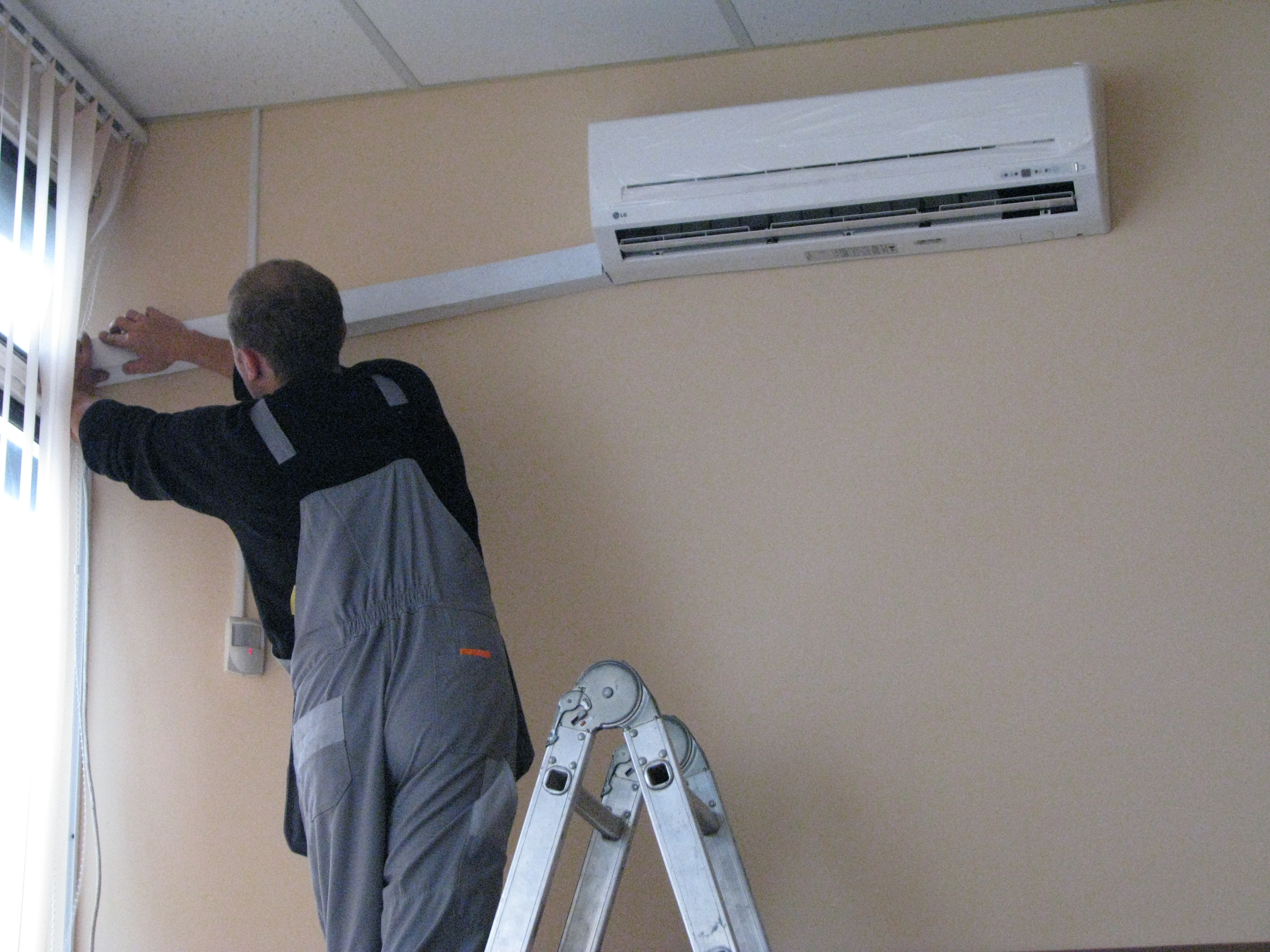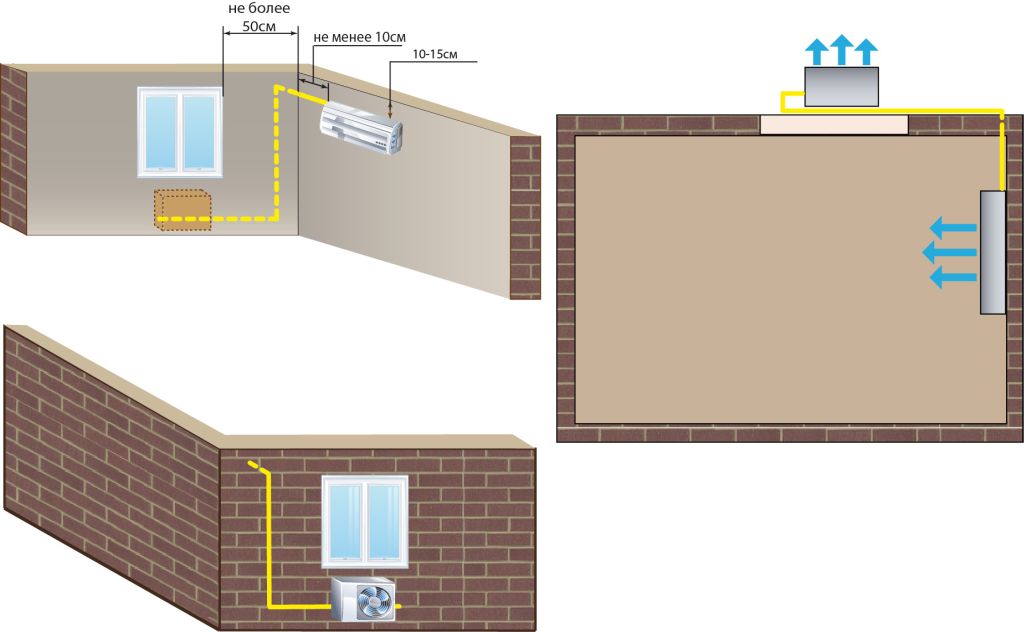Installation of a window air conditioner
 Window air conditioner
Window air conditioner
Installation of a window climatic device is a laborious task that requires the maximum care and accuracy from the contractor. Such an air conditioner is a one-piece unit, which simplifies installation a little. All work is performed in the following sequence:
- First, you need to decide on the installation location of the air conditioner and carefully prepare a double-glazed window for this. The window is marked according to the dimensions of the apparatus, then the glass is removed and a jumper is inserted. The place for installation is ready, the free space of the frame must be carefully glazed;
- Then the bracket and the device itself are installed. In this case, you need to ensure that the back wall is slightly inclined to drain condensate;
- Next, you need to attach a hose to drain the condensate. The hose must be perfectly flat, without kinks;
- A separate electric line is being connected under the air conditioner;
- Grounding is connected.
After that, it is worth checking the operation of the window air conditioner. If it doesn't turn on, it's worth checking all contacts and troubleshooting.
Possible limitations
There are no special requirements for such work, the rules for installing an air conditioner are usually regulated by the requirements of the SES (they may differ in each region). In addition, some municipalities may impose restrictions on aesthetics. For example, in historical centers, or in buildings that are classified as cultural heritage (or are historical monuments), local authorities may establish special rules for installing air conditioners on the facades of buildings. Often, such restrictions generally prohibit changing the appearance of an architectural structure. In such cases, climate systems with external modules are mounted on the roof (provided that they cannot be seen).
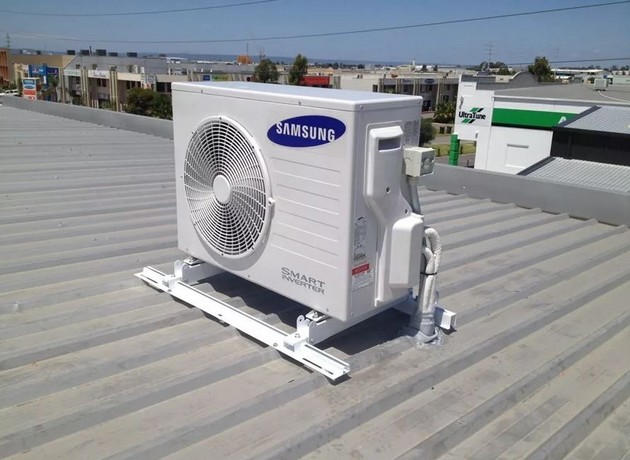
From a technical point of view, there are no additional difficulties, except that the line with freon will be significantly longer (which means the cost of installation work will increase). Another possible problem is the lack of protection from vandals and intruders (thieves). When the outdoor unit is located on the wall of a building, it is not available for external intervention.
Sometimes, the literal fulfillment of such requirements leads to an aesthetic absurdity.
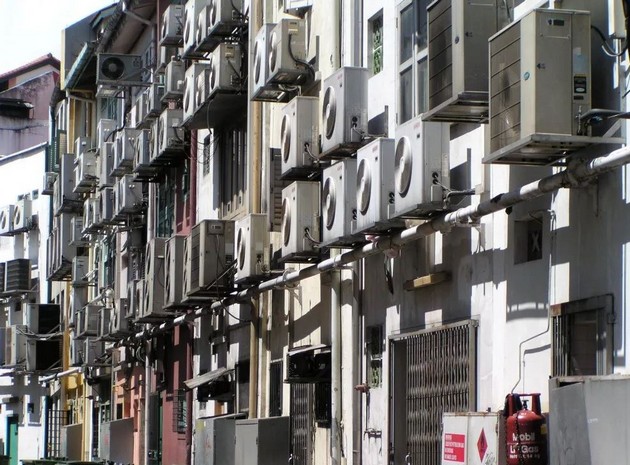
In some cases, the problem of organizing the climate (especially if it is an independent installation of the air conditioner) is solved by the selection of models:
- window air conditioner does not change the appearance of the historical building so much;
- floor systems are not visible from the outside at all.
We will consider all the ways how to install an air conditioner with your own hands, with the exception of the ducted climate system.
The safety requirements for the installation of outdoor units are also taken into account. Heavy equipment placed at a height of several tens of meters is a potential hazard if dropped. Therefore, the mounting brackets must be reliable.
The electrical wiring diagram for the air conditioner must comply with the Electrical Installation Rules (PUE), like any powerful electrical appliance. In addition, energy consumption cannot exceed the technical conditions (TU) of the input connection of the facility. Before purchasing, you need to calculate the total power of your electrical appliances, and compare the result with the restrictions set by the company that supplies the electricity. It is advisable that there is no need to turn off the climate system when turning on the boiler or iron. Otherwise, it can lead to overloads and emergencies.
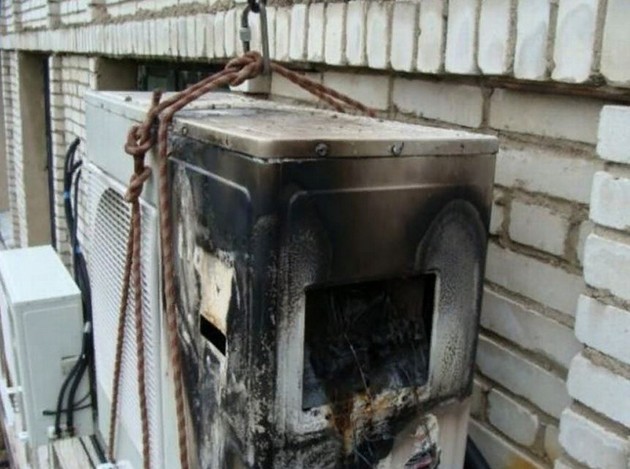
Fastening the outdoor unit
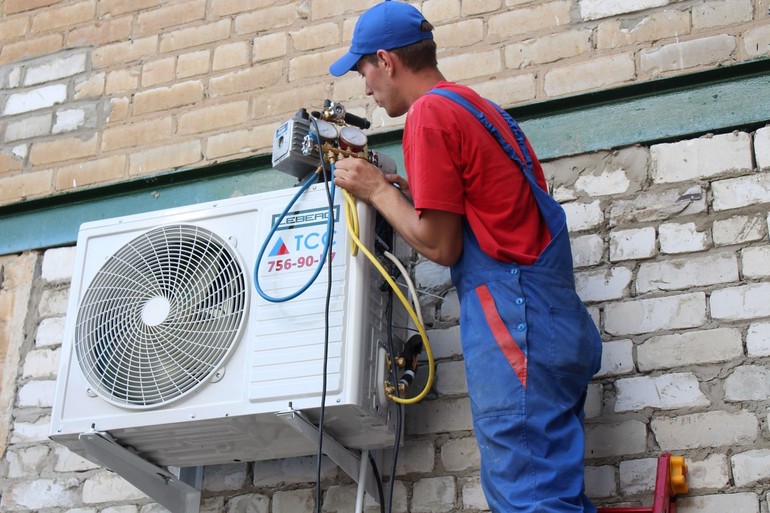
Fastening an outdoor unit in a private house does not require much effort, but in the case of an apartment building, things are much more serious. In this case, you need to carefully consider the location of the outdoor unit so that it does not interfere with neighbors and does not cause condensation to drain down the wall of the house. But it is also unacceptable to install the unit at a great distance from the balcony, since after some time it will need to be replaced or serviced.
Experts recommend installing the unit on the east or north side of a window or balcony, usually at the bottom. In this case, it will not interfere with anyone, and it will be possible to reach it simply through an open window. Using a good level, determine the attachment points for the brackets and drill holes in the wall for the anchor bolts.
When laying interblock communications, a through hole should be made. Its diameter can be 80 mm. When working in a brick wall, it is best to start drilling along the seam between the bricks. This approach will reduce the useful time, and the hole itself will be as accurate as possible.
The brackets are fixed according to the previously made markings, leveled with a building level, and then securely bolted. The outdoor unit must be installed in such a way that there is at least 10 cm between the radiator and the surface of the wall structure. Connection and subsequent start-up of the system are carried out a little later, after which the formed gaps are closed. After making sure that the block is securely fixed, you can begin the next stage.
Indoor unit
When installing industrial air conditioners, you need to understand not only the device of the external unit, but also the internal one.
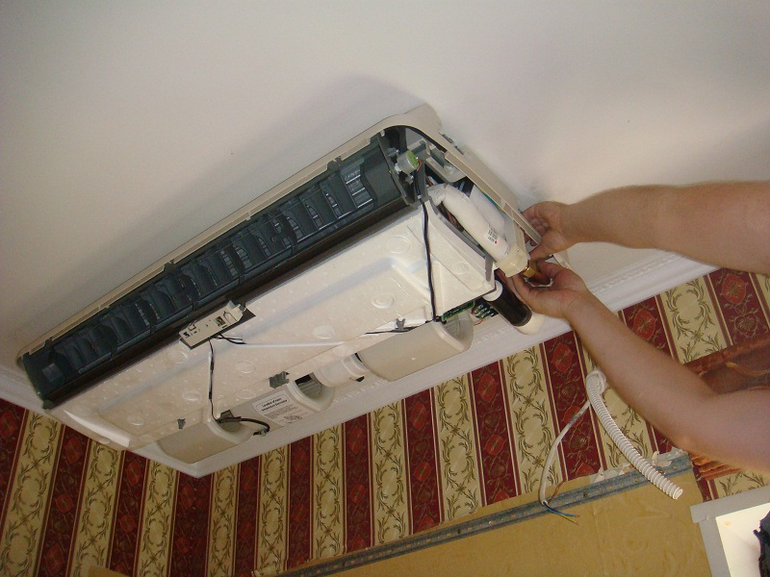
This part of the system consists of the following parts:
- Front Panel. It is a small plastic grill that allows air to pass through. The panel is easy to clean as it can be removed with little effort.
- Coarse filter. It is made in the form of a plastic mesh and is able to retain large particles of debris, such as coarse dust, animal hair and others. In order for the air conditioning system to work for a long time and without interruptions, the filter must be cleaned at least twice a month.
- Fine filter. It can differ in different types of performance and functions: the carbon version fights against unpleasant odors, the electrostatic version protects the system from fine dust, and so on. But unlike the previous unit, the fine filter practically does not affect the efficiency of the system.
- Fan. Has three or four rotation speeds.
- Evaporator. It is a radiator that heats cold air masses and their further evaporation.
- Horizontal blinds. Able to change the direction of the air vertically. The structure is equipped with an electric drive, and its position is changed using a remote control. The blinds also support automatic operation, making oscillatory movements at a certain interval.
- Vertical blinds. Regulate the air flow in the horizontal direction. Domestic units only support manual positioning, while more advanced premium air conditioners are controlled by a remote control.
- Indication panel. On the front panel of the air conditioning system, there are LEDs that determine the current mode of operation and any breakdowns.
- Condensate tray. It is located under the evaporator and is an important element for collecting all kinds of condensate. From the sump, water is discharged to the outside through a drain hose.
- Control board. In most cases, the unit is located on the right side of the indoor unit and is equipped with an electronics box with a central microprocessor.
The principle of operation of the air conditioner, split system
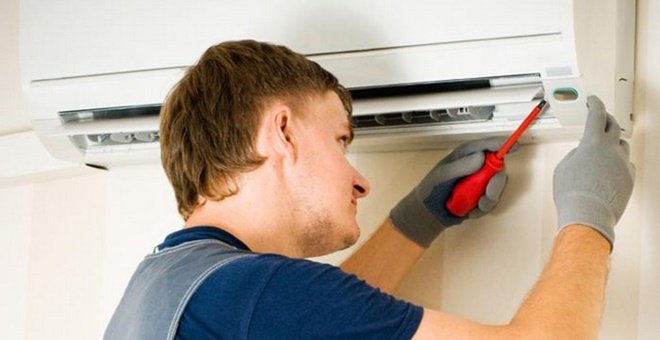
To form a general idea of the organization of the internal device, and before installing the air conditioner, we recommend that you consider the principle of the system. The climatic device consists of 2 equivalent units - compressor and evaporative. They are connected to each other with special adapters, pipes and pipes.
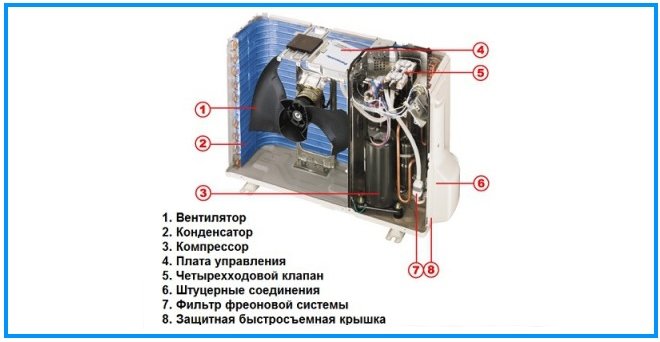

High pressure refrigerant is directed to the evaporator section. Then the freon expands, its gradual boiling and vaporization. It is this cold vapor that absorbs the warmth of the air. The air conditioning unit works with the active formation of water condensate, which settles on a special radiator. At the final stage, water is removed from the building through a special pipe.
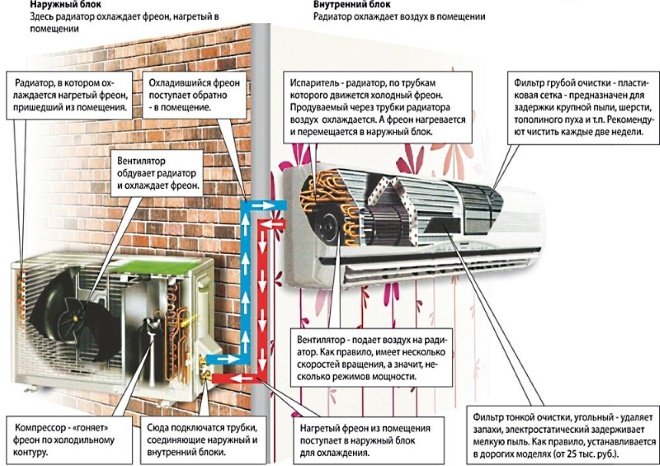
In the process of operation, the compressor is pumped out vapors of freon. The pressure inside the unit is increased by a built-in pump. Gradually, the refrigerant under the influence of temperature changes from a liquid state to a vapor state. Dense "fog" is directed into the condensate chamber for gradual cooling (for this purpose a small fan is used) and transition to a liquid state. Then the circle closes and the process loops.
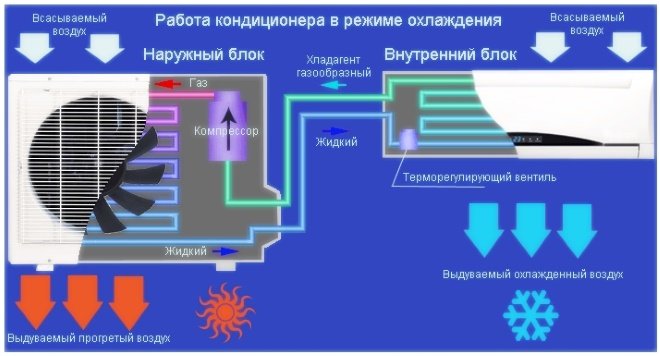
The efficiency and duration of the operation of the air conditioner at home, as well as the amount of electricity consumed by the device, are determined by the intensity of operation of the unit, the climatic features of the region. If there is a heater in the room near the climatic device, the level of consumed electricity increases, which is fraught with the failure of the device. Even ordinary dust can provoke a breakdown. Regular wet cleaning is prescribed for the room.
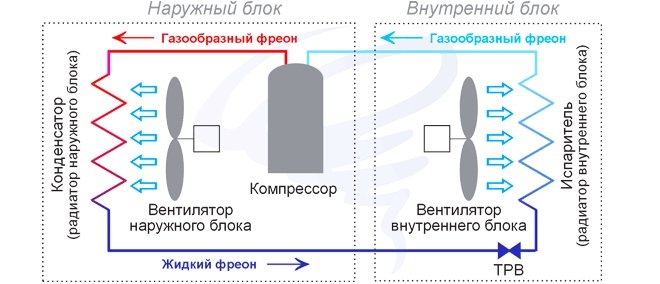
Functional diagram of the climatic device
Couplings and joints require sealing without fail in order to neutralize the likelihood of evaporation of freon or other refrigerant. The installation of the outdoor unit of the air conditioner is carried out in such a way that the level is lower than the internal part of the unit. The outer node is located in a dark place, away from sunlight.
The comfort of the microclimate in the house and the uninterrupted functioning of the climatic apparatus depend on the observance of the basic recommendations indicated above.
Basic installation requirements
The correct installation scheme will help you install a split system in the apartment. Before installation, they study the norms and requirements for the installation of such equipment.
Indoor unit
When installing the indoor unit, the following features are taken into account:
- Since the air conditioning system consumes two kilowatts of electricity, its indoor unit is connected to a separate line equipped with a fuse.
- Before installation, carefully consider the features of the placement of the wiring. It is not recommended to lay it in the load-bearing wall or in the joints between the slabs.
- The indoor unit is placed so that the distance to the outside is at least 15 centimeters.
External block
Before installing the outdoor unit, please read the following installation requirements:
- The structure is installed only on a flat surface that can withstand a load of 65 kilograms.
- You cannot put the block on walls made of aerated concrete.
- When installing, be sure to use a building level so that there are no distortions.
- The tube connected to the structure is taken out into the sewage system.
- During the installation process, a gap of 10-15 centimeters is made between the wall and the body.
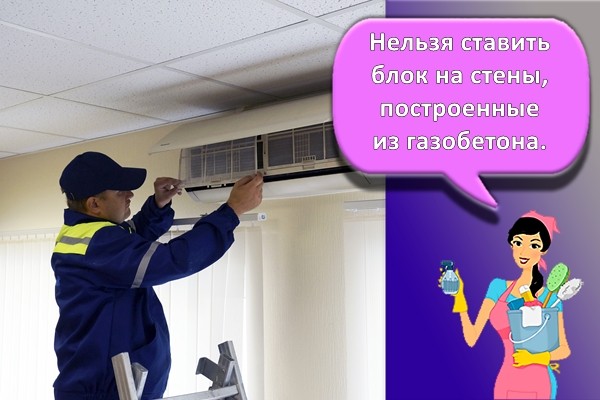
What are the air conditioners
There are many types of air conditioners. While some of them require little effort to install, others will require a fair amount of tinkering. Air conditioners are as follows:
- Window type;
- Wall-mounted;
- Outdoor;
- Wall and ceiling;
- Floor and ceiling;
-
Cassette;
- Column;
- Duct;
- Multi split systems;
- Multizone;
- Precision.
Window-type devices are the cheapest and most primitive. They are easy to install, but they are low-powered and therefore it is impossible to cool a large room with high quality using this technique.
Wall mounted air conditioners or split systems are the most popular for domestic use. You can choose them in any suitable design and at any price: from cheap Chinese ones to expensive branded models.
Floor-mounted climatic technology is used where it is impossible to install the air conditioner on the wall. For example, in buildings with significant glazed surfaces. These air conditioners cool well and, if necessary, warm up the room.
Wall-ceiling devices are used in rooms without false ceilings or in oblong-shaped rooms. The jet of air is dissected along the surface of the walls and ceiling, while qualitatively cooling the room.
Floor and ceiling systems can be installed in rooms of the most intricate shapes. The air flow at a comfortable temperature covers the entire area as much as possible. Such air conditioners can be mounted on the ceiling and near the floor - this does not affect the quality of work.
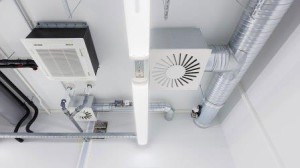 Cassette air conditioner
Cassette air conditioner
Cassette air conditioners simultaneously provide four equal flows of cooled air, which allows you to quickly make the room temperature comfortable. Such devices are more often used in non-residential premises.
Column systems are installed in large buildings of historical or other value. Such devices do not need to be fixed, therefore, the surface of the walls does not deform.
Ducted systems make it possible to simultaneously condition several rooms. Due to hidden communications, such a device can easily fit into any interior. The great advantage of this type is the possibility of adding fresh air.
Multi split systems are installed in those buildings where it is undesirable to pile up many external blocks on the facade. One such outdoor unit is capable of serving up to ten indoor units. The cost of such air conditioners is much higher than that of a conventional split system.
Multi-zone systems are used to air conditioning large spaces such as shopping malls, entertainment venues, hospitals and schools.
Precision systems are intended for commercial purposes. They are designed for year-round operation, without shutting down. Such devices are successfully used in various storage facilities, operating rooms of hospitals and other special-purpose buildings.
Operating principle
Before proceeding with the independent installation of the air conditioning system, you should understand the intricacies of its work. This is necessary for the correct distribution of important nodes in order to achieve the best efficiency. The key components of every air conditioner are the compressor and the evaporator unit, which are connected by pipes.
The first element is installed outside the house, on a balcony or outside wall, and the second is installed directly inside. Elite industrial-type models are equipped with not one indoor unit, but several at once, which interact with one powerful compressor.
The evaporative unit is designed to absorb heat by supplying refrigerant to the chamber. Once in the reservoir, the substance begins to expand and then boil, forming heat-absorbing vapors. This process is accompanied by the release of water condensate, which eventually settles on the radiator. Then the moisture moves into the container and is discharged outside through the tubes.
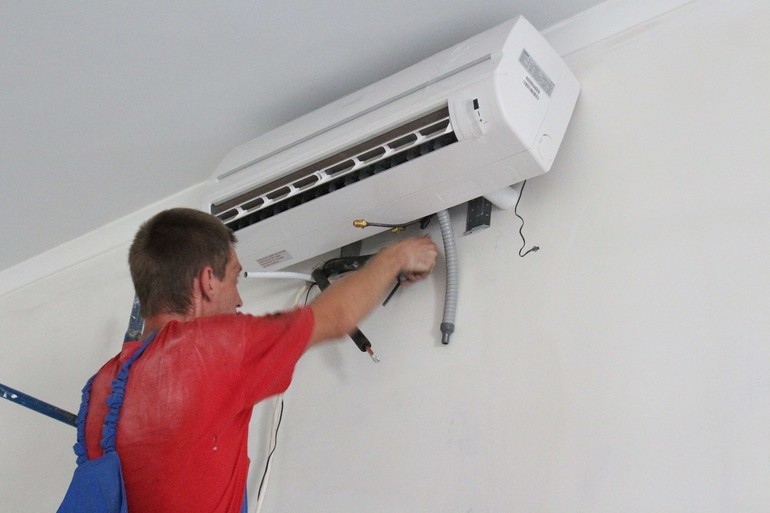
The task of the compressor is to evacuate the refrigerant vapor generated from the chamber by increasing the pressure downstream of the pump. This causes the refrigerant to heat up and transform into a dense mist. In this state, the working substance is directed into a special chamber with a radiator, undergoes a cooling procedure and again takes the form of a liquid.The process is repeated after the refrigerant is supplied to the nozzle of the evaporating unit.
Air conditioning efficiency and energy consumption are determined by the environment of use. If heating radiators are installed near the unit, the compressor will have to consume much more energy, which reduces its service life. Ordinary dust that ends up inside the equipment can lead to damage, so the wet cleaning procedure must be carried out often and thoroughly. Also, you cannot place all kinds of objects on the surface of the block or cover it with anything.
The joints and joints must be reliably protected from refrigerant vapors. The outdoor components are installed below the indoor ones and, as a rule, in the coldest place. Experts advise placing the unit under eaves of roofs or wall structures where shadow is present. Simple recommendations will have a positive effect on the installation of air conditioning.
Tool, accessories for device installation
Equipment for the installation of air conditioners includes a number of specialized equipment that allows you to easily equip the units with the necessary components for full operation. So, a pipe bender and a pipe cutter may be required - the devices allow you to change the configuration of the pipe without accompanying damage and without forming chips, since there is a risk of it getting into the filter system. The gauge station allows you to control the pressure level of the refrigerant. Installation and installation of air conditioners includes the need to control the tightness of the system before refueling with freon, a vacuum gauge is used for this.

When installing yourself, you need to purchase a kit for installing an air conditioner. Today there are ready-made kits that include all the necessary parts and elements for fully connecting the blocks and setting up their operation without losing the efficiency of the system. Typically, it includes different sizes of union nuts, thermal insulation material and copper pipes, a hose that acts as a drain, and two brackets for mounting the outdoor unit. The length of pipes and drainage is selected taking into account the configuration of the room, that is, you can choose a complete set that suits the individual requirements of the home.
All consumables for the installation of air conditioners are selected taking into account the model of equipment. You should also not save on the quality of connecting pipes, thermal insulation, fasteners and freon, since the duration of the air conditioning system's operation and the absence of the need for repairs directly depend on this, which can entail unnecessary costs.
Installation and maintenance of air conditioners, subject to regularity, will help to avoid such consequences, you just need to periodically clean the system and monitor the level of freon in it.
Installation features
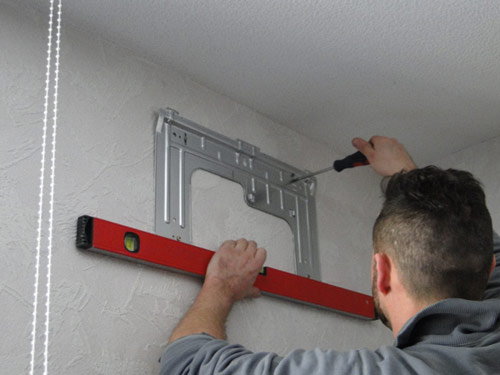
A mounting plate is usually included with the air conditioner, which is necessary for attaching the indoor unit of the device. The air conditioner installation scheme involves the preparation of a small project, which determines the exact location and height of installation of the indoor and outdoor units, the length and path of the connecting route.
At the same time, it is important to follow the sequence of actions, for which the instructions for installing the air conditioner have been created:
The first step is to mount the panel on the wall in a specific place, as well as at the appropriate level. Such nuances are precisely determined at the design stage. The mounting panel is installed using a building level, which will allow you to get a strictly horizontal line. The attachment points are marked with a pen / marker so as not to lose sight of the exact center distance.
Then a hole of sufficient size must be drilled in the wall for the routes to pass through it.If you do not have the appropriate equipment at hand, you can try to bring the connecting pipes through the window opening by drilling holes in the frame.
The installation and repair of air conditioners are directly related to each other: the more accurately and correctly all the work is performed, the less often it will be necessary to call a foreman to set up and repair the equipment. Therefore, you need to take into account even such nuances as the slope of the drainage hole, which will allow you to easily remove the accumulated moisture.
The installation of the outdoor unit of the air conditioner requires special care due to its heavy weight. Brackets are attached to the wall according to the size of the device
It is important that the thickness of the metal of these elements is sufficient to withstand such a load. All work that needs to be performed on floors above the second is performed only by high-rise installers.
Next, it remains to expand the pipes and fix the ends of the routes to each of the blocks. It should be noted that when drilling a hole in the wall for laying pipes, the minimum diameter is 5 cm. If the routes will pass through the window frame, a separate hole is drilled for each pipe. Thus, the installation of domestic air conditioners includes several basic steps and does not require significant financial investments if you know how to use the tool.
Internal works
When figuring out where to install the indoor unit, it is important to keep in mind one key rule: it should not be behind curtains, over heating appliances, or in rooms that have electrical interference that could damage the processor. Having decided on a suitable place, you need to check the wall for the absence of any communications, such as electrical wiring, water or heating pipes

The indoor unit is equipped with its own wiring with a cross section of 1.5 sq. mm. It must also be equipped with an automatic shutdown board. Upon completion of the wiring installation, it can be connected to the shield at the input, observing the following sequence of actions: the yellow wire with a green stripe is connected to the neutral wire. To determine the location of zero and phase, you need to apply an indicator.
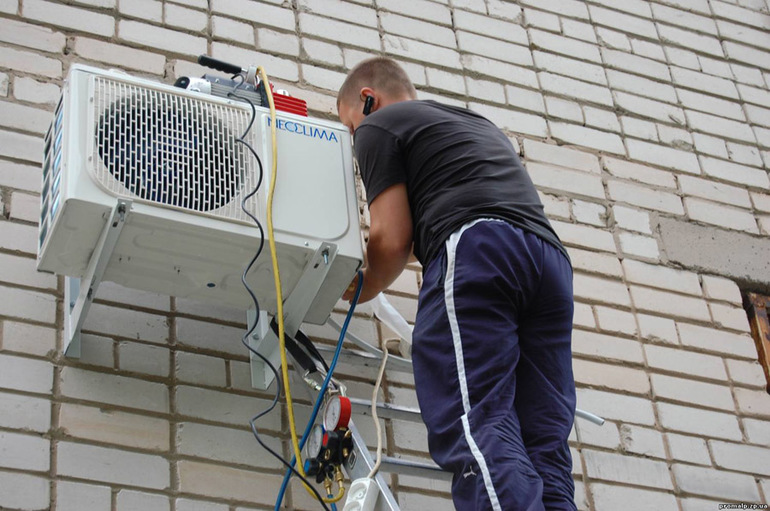
Copper pipes are cut into small pieces, leaving a bend margin of 800-100 centimeters. At the stage of bending the tubes, it is necessary to use special tools to prevent deformation or cracking of the metal surface. Also, the structure is additionally protected with polyurethane foam hoses. It is not recommended to use foam rubber for thermal insulation, as it is not sufficiently reliable and short-lived.
Threaded flanges are fixed to the insulated pipe, after which the process of their expansion begins.
When carrying out such work, it is important to be very careful, otherwise cracks and grooves may appear on the tubes. The nuts should slide easily on the flare, and it is better to use a torque wrench when tightening.
This approach will prevent the flared connections from being squeezed out of the nut.



